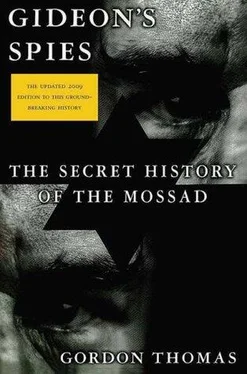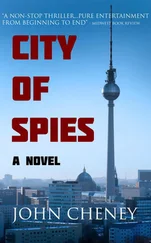Gordon Thomas - Gideon's Spies
Здесь есть возможность читать онлайн «Gordon Thomas - Gideon's Spies» весь текст электронной книги совершенно бесплатно (целиком полную версию без сокращений). В некоторых случаях можно слушать аудио, скачать через торрент в формате fb2 и присутствует краткое содержание. Город: New York, Год выпуска: 2009, ISBN: 2009, Издательство: Thomas Dunne Books, Жанр: История, на английском языке. Описание произведения, (предисловие) а так же отзывы посетителей доступны на портале библиотеки ЛибКат.
- Название:Gideon's Spies
- Автор:
- Издательство:Thomas Dunne Books
- Жанр:
- Год:2009
- Город:New York
- ISBN:978-0-312-53901-6
- Рейтинг книги:4 / 5. Голосов: 1
-
Избранное:Добавить в избранное
- Отзывы:
-
Ваша оценка:
- 80
- 1
- 2
- 3
- 4
- 5
Gideon's Spies: краткое содержание, описание и аннотация
Предлагаем к чтению аннотацию, описание, краткое содержание или предисловие (зависит от того, что написал сам автор книги «Gideon's Spies»). Если вы не нашли необходимую информацию о книге — напишите в комментариях, мы постараемся отыскать её.
Gideon’s Spies
Gideon's Spies — читать онлайн бесплатно полную книгу (весь текст) целиком
Ниже представлен текст книги, разбитый по страницам. Система сохранения места последней прочитанной страницы, позволяет с удобством читать онлайн бесплатно книгу «Gideon's Spies», без необходимости каждый раз заново искать на чём Вы остановились. Поставьте закладку, и сможете в любой момент перейти на страницу, на которой закончили чтение.
Интервал:
Закладка:
Outside the villa, Abu Jihad’s driver was asleep in the Mercedes. One of Sword’s men ran forward, pressed a silenced Beretta into his ear, and pulled the trigger. The driver slumped dead across the front seat.
Next, Sword and another member of the hit team laid an explosive charge at the base of the villa’s heavy iron front door. A new type of “silent” plastic explosive, it made little sound as it blew the doors clean off their hinges. Inside, two of Abu Jihad’s bodyguards were standing in the entrance hall, too stunned by the explosion to move. They, too, were shot dead by silenced weapons.
Running to the study, Sword found Abu Jihad watching video footage of the PLO. As he rose to his feet, Sword shot him twice in the chest. Abu Jihad crashed heavily to the floor. Sword stepped quickly forward and put two more bullets through his forehead.
Leaving the room, he encountered Abu Jihad’s wife. She was holding her small son in her arms.
“Get back to your room,” Sword ordered in Arabic.
Then he and the team vanished into the night. From the time they had entered the villa to departure had taken them only thirteen seconds—nine vital seconds better than their best practice run.
For the first time, an Israeli assassination met with public criticism. Cabinet minister Ezer Weizman warned that “liquidating individuals will not advance the peace process.”
Nevertheless the assassinations continued.
Two months later, South African police were finally forced to reveal a secret that Israel had pressed them to keep: Mossad had executed a Johannesburg businessman, Alan Kidger, who had been supplying high-tech equipment to Iran and Iraq that could be used to manufacture biochemical weapons. Kidger had been found with his arms and legs amputated. Johannesburg’s chief police investigator, Colonel Charles Landman, said the killing was a “clear message from the Israeli government through its Mossad.”
Six weeks before the execution of Abu Jihad, Mossad had played an important role in another controversial assassination—that of three unarmed members of the IRA shot dead on a Sunday afternoon in Gibraltar by a team of Britain’s Special Air Services marksmen.
In previous years, some of their colleagues from British intelligence had been secretly brought to Tel Aviv by Rafi Eitan to witness firsthand how Mossad executed Arab terrorists in the back streets of Beirut and Lebanon’s Bekáa Valley.
Four months before the Gibraltar shootings, Mossad agents had begun their own surveillance of Mairead Farrell, Sean Savage, and Daniel McCann in the belief they were once more on a “shopping spree for Arab arms for the IRA.”
Mossad’s close interest in the activities of the IRA went back to the time when the Thatcher government had, in the utmost secrecy, brought Rafi Eitan to Belfast to brief the security forces on the developing links between the Irish terror groups and the Hezbollah.
“I arrived on a rainy day. It rained every day I was in Ireland. I told the British all we knew. Then I went on a tour of the province, all the way down to the border with the Republic. I was careful not to cross over. Imagine what the Irish government would have said if they’d picked me up! Before I left I arranged for the SAS to come to Israel so they could see something of our methods in handling terrorists.”
From those early beginnings a close working relationship developed between the SAS and Mossad. Senior Mossad officers would regularly travel to SAS headquarters in Hereford to brief special forces on operations in the Middle East. On at least one occasion a joint Mossad-SAS unit trailed several high-ranking IRA men from Belfast to Beirut and photographed them in meetings with Hezbollah leaders.
In October 1987, Mossad agents tracked the tramp steamer Eksund as it made its way through the Mediterranean with 120 tons of arms, including surface-to-air missiles, rocket-propelled grenade launchers, machine guns, explosives, and detonators. All had been purchased through IRA contacts in Beirut. The Eksund was intercepted by the French authorities.
Unable to make headway with the Irish security authorities—at least one Mossad officer still believed this stemmed from Israel’s strong opposition to Ireland’s peacekeeping role in Lebanon—Mossad used Britain’s SAS as a conduit to tip off Dublin about other arms shipments heading for Ireland.
The Mossad agents trailing the IRA commando unit in Spain quickly decided they were not there to meet Arab arms dealers, nor to make contact with ETA, the Basque terrorist group. Nevertheless, the Mossad team continued to dog the footsteps of Spain’s International Terrorism Unit, who were also following the Irish trio.
At first there was a keep-your-distance attitude by the Spaniards. This was their operation—the first time they had become seriously involved with both MI5 and the SAS in dealing with the IRA. Understandably, the Spaniards wanted to ensure the glory, if it came, would be theirs. Mossad quickly made it clear that all they wanted to do was help. Relieved, the Spaniards were soon working together with Mossad.
When the Spanish lost track of Mairead Farrell, it was a katsa who located her. He discovered that Farrell had hired another car, a white Fiesta, and parked it, loaded with sixty-four kilos of Semtex and thirty-six kilos of shrapnel, in an underground parking lot in Marbella.
The fashionable resort is not only a favorite refuge from the fierce desert sun where a number of Arab notables spend their time dreaming of the day the hated Israel will be overrun; Marbella is only a short distance from the raffish marina of Puerto Banus, where many Arab petrodollar millionaires kept their luxury yachts. Mossad had long feared that the boats traveled the length of the Mediterranean to smuggle explosives and weapons to Arab terrorists. Farrell’s car was suspected of being parked for that purpose, ready to be hoisted on board a boat ostensibly bound on a cruise to the Holy Land.
The Mossad team conducted surveillance on the car. They also spotted Farrell at the wheel of another Fiesta, the one she had used to drive McCann and Savage around Spain these past weeks. Two of the Mossad team followed the IRA unit as it drove south toward Puerto Banus. Ten minutes after leaving Marbella, Farrell passed the entrance to the marina and continued on down the coast.
Using their car radio tuned to the police channel, the Mossad katsa alerted the Spanish police that the IRA trio were heading toward Gibraltar. The Spanish alerted the British authorities. The SAS team moved into position. Hours later Farrell, McCann, and Savage were shot dead. They were given no warning or chance to surrender. They were executed.
A week later, Stephen Lander, the MI5 officer officially credited with running the operation—and who would later become director general of MI5—telephoned Admoni to thank Mossad for their help with the assassination.
On that October evening in 1995, in the safe house off Pinsker Street, all was ready for the meeting to settle the next assassination.
Selected for execution was the religious head of Islamic Jihad, Fathi Shkaki. Mossad had established that his group had orchestrated the deaths of over twenty Israeli passengers in a bus destroyed the previous January by two suicide bombers outside the small town of Beit Lid.
The incident brought the number of terrorist attacks to over ten thousand in the last quarter century. In that time over four hundred Israelis had been killed and another thousand injured. Many of those responsible for this catalog of death and maiming had themselves been hunted down and killed in what katsa Yaakov Cohen, who had himself done his share of revenge taking, would describe as “all those back streets that have no names; where a knife can be more effective at times than a gun; where it’s either kill or be killed.”
Читать дальшеИнтервал:
Закладка:
Похожие книги на «Gideon's Spies»
Представляем Вашему вниманию похожие книги на «Gideon's Spies» списком для выбора. Мы отобрали схожую по названию и смыслу литературу в надежде предоставить читателям больше вариантов отыскать новые, интересные, ещё непрочитанные произведения.
Обсуждение, отзывы о книге «Gideon's Spies» и просто собственные мнения читателей. Оставьте ваши комментарии, напишите, что Вы думаете о произведении, его смысле или главных героях. Укажите что конкретно понравилось, а что нет, и почему Вы так считаете.












